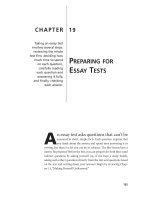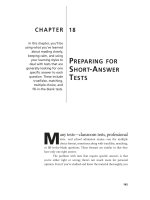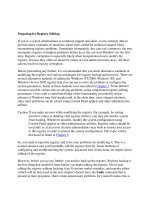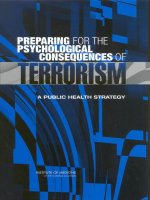Preparing for Essay Tests
Bạn đang xem bản rút gọn của tài liệu. Xem và tải ngay bản đầy đủ của tài liệu tại đây (88.06 KB, 12 trang )
155
CHAPTER
19
P
REPARING FOR
E
SSAY
T
ESTS
Taking an essay test
involves several steps:
reviewing the whole
test first, deciding how
much time to spend
on each question,
carefully reading
each question and
answering it fully,
and finally, checking
each answer.
A
n essay test asks questions that can’t be
answered in short, simple facts. Each question requires that
you think about the answer and spend time answering it in
writing, but there is a lot you can do in advance. The Boy Scouts have a
motto: Be prepared! Before the test, you can prepare for both direct and
indirect questions by asking yourself (or, if you have a study buddy,
asking each other) questions directly from the text and questions based
on the text and writing down your answers. Begin by reviewing Chap-
ter 15, “Making Yourself Understood.”
Use Your Study Styles
Mathilda is studying to be an accountant and she just learned
she’ll have to take an essay test to complete the class. Her math
teacher wants to see how she thinks and solves problems. “But
I just work with numbers!” she says. “I don’t need to write in
this job!” What Mathilda will see is that she can use her
strength as someone who works best with order as a sequential
learner to become a sequential writer.
HOW TO STUDY
156
GETTING READY
A good way to prepare yourself for an essay question is to write a mock
test ahead of time. By acting (creating questions) and not just reacting
(answering questions), you become involved in the test preparation
process. To begin, pretend you’re the instructor:
• Make a list of what you want your students to get out of the
course and the class materials, such as hand-outs, pamphlets, and
books.
• Circle the three items you feel are most important to the course.
• Make up a question for each of these items. If you’re working
with a study buddy, each make up your own list and separate
questions. Include both direct questions, which are answered by
facts from your notes or text, and at least one indirect question,
which is based on how you put facts together to come up with
a conclusion.
• Write an answer to each question. If you’re working with a study
buddy, swap the tests you made and take each other’s test. Make
sure you each have an answer sheet that includes page numbers
that indicate where the answers can be found in your class material.
TIME MANAGEMENT
You want to make the most of the time allotted for taking the test so that
you have sufficient time for answering and checking each question before
the time is up.
PREPARING FOR ESSAY TESTS
157
I
FTHE
W
HOLE
T
EST
I
S
E
SSAY
Q
UESTIONS
For an all-essay-question test:
• Read the entire test over before you start to answer any questions.
• Count the number of questions and make note of how much time
you have left to complete the test. Give yourself a rough time limit
for each question; this includes time for checking and correcting
your answers!
• First answer the easiest questions.
• When you go back to answer tougher questions, begin with ones
you’re more comfortable with. There’s bound to be some that seem
less difficult than others. Sometimes writing on a topic you know
well reminds you of something you’d forgotten. A “bell” might go
off in your head, making a tough question easier to answer.
I
F
O
NLY
P
ART OF THE
T
EST
I
S
E
SSAY
Q
UESTIONS
Be on the lookout for certain parts of the test that count more heavily
than others. For example, maybe an essay counts for 50 percent of the test
grade, a multiple-choice section 25 percent, and a fill-in-the-blank sec-
tion 25 percent. While you want to spend your time where the largest
percentage is, it still makes sense to go to those questions whose answers
come to you first. It’s OK to do most tests out of order.
K
EEP
C
ALM
Sometimes even a topic you know well seems strange and confusing when
you’re nervous. Take deep breaths, relax. (You may want to review the tips
for keeping calm in Chapter 1, “Getting Started.”) If the test is going to be
several hours long, see if you’re permitted to bring some juice or a bottle of
water with you. And if there’s a chance you might be cold, bring along a
sweater. You don’t have to wear it, but you’ll be happy you have it if you feel
chilly. Being comfortable can help you stay calm.
UNDERSTANDING THE TEST QUESTION
The first step in successfully answering an essay question is making sure
you understand what it’s asking! This may seem obvious but it’s not
unusual for test-takers under pressure to misread questions. You may
HOW TO STUDY
158
want to review Chapter 10, “Getting More Out of Reading.” Also, see the
section below on reading different kinds of essay questions.
T
YPES OF
Q
UESTIONS
Some questions ask you something directly, such as “Where and when
did such-and-such happen?” Others are more indirect, like “If such-and-
such had not happened, what might the situation be today?” A question
might—or might not—have been discussed in class or in the text you
read.
Direct Questions
If the question is direct, you know what you’re being asked and how to
go about answering it. There’s usually only one correct answer.
Indirect Questions
If it’s an indirect question, you have to figure out what is being asked.
Usually there is not one correct answer but several possible answers,
depending upon your interpretation, opinion, or reaction to the question
and the subject matter. What often helps in figuring out your answer to
an indirect question is to try to get the feeling of the question. In the
example, “If such-and-such had not happened, what might the situation
be today?” ask yourself what kind of a feeling you would you have if
such-and-such had not happened? Write down the feeling, then explain
why you had that feeling.
COMING UP WITH THE ANSWER
G
ETTING THE
I
DEA
An advantage of an essay test is that extended writing actually gets you to
think more clearly than just writing a one- or two-word answer. When
you write, you’re using much of your brain. You may want to use scrap
paper to write quickly everything you know about the question as soon
as you read it. Or you may want to write an outline, “talk” to yourself
about the question (but not aloud; your fellow test-takers won’t appreci-
ate it!), or perhaps visualize the answer first.
If it’s an indirect question, keep in mind that your opinion counts.
Close your eyes for a few seconds to clear your head and let the answer
come to you. On scrap paper, jot down the important facts that will prove
PREPARING FOR ESSAY TESTS
159
your answer. Draw lines or number the facts to help you make connec-
tions and determine which facts you want to use in your answer and in
what order they should be presented.
U
SE
Y
OUR
L
EARNING
S
TYLE TO
C
LARIFY
Y
OUR
A
NSWER
The way you plan what you’re going to say depends on what works best
for you. For any learning style, you want to have a clear idea of the whole
answer—your complete response to the question—before you actually
write it, whether it’s a few sentences or a few pages long.
Since she learns best through order, as a sequential thinker, Mathil-
da, (see box) found that if she made a numbered outline, she could see
the order of what she’d be writing, and it would make a lot more sense to
her. Then, she would write sentences describing each category in her out-
line. If she had been a global thinker who worked best with images, she
would have written or drawn questions and ideas, and then linked them
with lines or numbers. In other words, the sequential thinker thinks in
order first, the global thinker thinks in order last.
• If you learn best by hearing: Try saying a sentence out loud (softly!)
before writing it down.
• If you learn best by seeing: Try drawing or writing down ideas on
scrap paper before you write the essay.
• If you learn best by doing: Imagine yourself acting out your
answers. It’s OK to make small movements with your hands in
most testing situations, so take advantage of this opportunity.
Then start writing what you’re acting out.
• If you learn best by order: Let your writing describe the order of
events you are remembering.
• If you learn best by images: Let your writing describe the picture
that’s in your head.
1.
2.
3.









